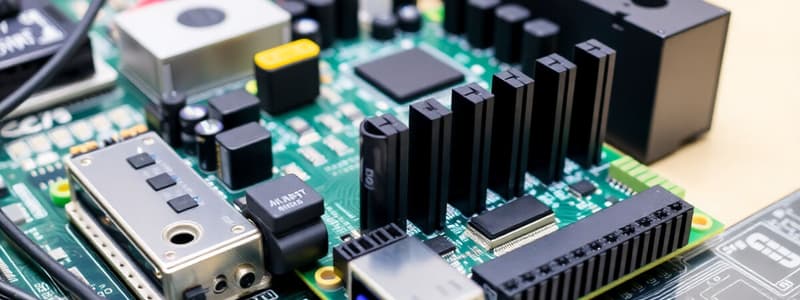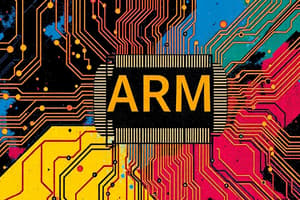Podcast
Questions and Answers
Which ARM register is typically used for system calls, indicating the desired action to the OS?
Which ARM register is typically used for system calls, indicating the desired action to the OS?
- R0
- PC
- R7 (correct)
- LR
What does the acronym CPSR stand for in ARM architecture?
What does the acronym CPSR stand for in ARM architecture?
- Control Program Status Register
- Current Program Storage Register
- Central Processing System Register
- Current Program Status Register (correct)
Which register stores the memory address to return to after the function call is finished?
Which register stores the memory address to return to after the function call is finished?
- SP (Stack Pointer)
- LR (Link Register) (correct)
- PC (Program Counter)
- R7
When does the Negative flag (N) in CPSR get set?
When does the Negative flag (N) in CPSR get set?
When is the Zero flag (Z) in the CPSR set?
When is the Zero flag (Z) in the CPSR set?
In ARM assembly, what is the primary function of registers R0-R3?
In ARM assembly, what is the primary function of registers R0-R3?
What is the primary function of the SPSR register in ARM architecture?
What is the primary function of the SPSR register in ARM architecture?
In ARM assembly, what is the result of the logical operation AND R2, R0, R1 if R0 = 0b1010 and R1 = 0b1100?
In ARM assembly, what is the result of the logical operation AND R2, R0, R1 if R0 = 0b1010 and R1 = 0b1100?
If register R0 contains the value 0xFF (0b11111111) and register R1 contains the value 0x0F (0b00001111), what will be the value of register R2 after the operation EOR R2, R0, R1?
If register R0 contains the value 0xFF (0b11111111) and register R1 contains the value 0x0F (0b00001111), what will be the value of register R2 after the operation EOR R2, R0, R1?
What is the result of the MVN R1, R0 instruction if R0 holds the value 0x00000001?
What is the result of the MVN R1, R0 instruction if R0 holds the value 0x00000001?
In ARM assembly, the instruction MVN R1, R0 is used to perform a bitwise NOT operation. If R0 = 0, what would be the decimal value of R1 after this operation?
In ARM assembly, the instruction MVN R1, R0 is used to perform a bitwise NOT operation. If R0 = 0, what would be the decimal value of R1 after this operation?
Which logical operation is not natively supported and requires two instructions to implement?
Which logical operation is not natively supported and requires two instructions to implement?
What is the combined effect of the following ARM assembly instructions, assuming R0 = 1 and R1 = 1: AND R2, R0, R1 followed by MVN R2, R2?
What is the combined effect of the following ARM assembly instructions, assuming R0 = 1 and R1 = 1: AND R2, R0, R1 followed by MVN R2, R2?
If R0 = 0b1100 and R1 = 0b1010, what is the value of R2 after the following instructions: AND R2, R0, R1 and MVN R2, R2?
If R0 = 0b1100 and R1 = 0b1010, what is the value of R2 after the following instructions: AND R2, R0, R1 and MVN R2, R2?
In the context of ARM assembly, what does "native" support for a logical operation imply?
In the context of ARM assembly, what does "native" support for a logical operation imply?
Given R0 = 0b1100 and R1 = 0b1010, what is the result of executing the following instructions: ORR R2, R0, R1 followed by MVN R2, R2?
Given R0 = 0b1100 and R1 = 0b1010, what is the result of executing the following instructions: ORR R2, R0, R1 followed by MVN R2, R2?
Which of the following best describes the additional overhead introduced by using a non-native logical operation like NAND in ARM assembly?
Which of the following best describes the additional overhead introduced by using a non-native logical operation like NAND in ARM assembly?
What is the result of EOR R2, R0, R1 followed by MVN R2, R2 if R0 = 0b1100 and R1 = 0b1010?
What is the result of EOR R2, R0, R1 followed by MVN R2, R2 if R0 = 0b1100 and R1 = 0b1010?
In ARM assembly, if R0 contains the value 5 and R1 contains the value 3, what will R2 contain after executing ANDS R2, R0, R1?
In ARM assembly, if R0 contains the value 5 and R1 contains the value 3, what will R2 contain after executing ANDS R2, R0, R1?
What would be the output, in decimal, of the following ARM code snippet?
MOV R0, #10
MOV R1, #3
EORS R2, R0, R1
What would be the output, in decimal, of the following ARM code snippet?
MOV R0, #10
MOV R1, #3
EORS R2, R0, R1
Which URL provides access to an ARM emulator?
Which URL provides access to an ARM emulator?
Which of the following registers in ARM assembly is used to hold the memory address of the next instruction to be executed?
Which of the following registers in ARM assembly is used to hold the memory address of the next instruction to be executed?
The Carry flag (C) in CPSR is set when?
The Carry flag (C) in CPSR is set when?
The Overflow flag (V) in the CPSR is set when?
The Overflow flag (V) in the CPSR is set when?
Assume R0 = 5. What will R1 contain after the following is run?
MVN R1, R0
Assume R0 = 5. What will R1 contain after the following is run?
MVN R1, R0
Registers R4-R6 are typically for?
Registers R4-R6 are typically for?
What will R2 contain after the following code block is executed, if R0 = 1 and R1 = 0?
ORR R2, R0, R1
What will R2 contain after the following code block is executed, if R0 = 1 and R1 = 0?
ORR R2, R0, R1
Given R0 = 0b1010 and R1 = 0b1100, what is R2 after executing the instruction AND R2, R0, R1?
Given R0 = 0b1010 and R1 = 0b1100, what is R2 after executing the instruction AND R2, R0, R1?
If register R0 = 0b11110000 and register R1 = 0b11111111, what is the value of register R2 after executing the following assembly instruction?
ANDS R2, R0, R1
If register R0 = 0b11110000 and register R1 = 0b11111111, what is the value of register R2 after executing the following assembly instruction?
ANDS R2, R0, R1
In ARM assembly, which instruction performs a bitwise exclusive OR operation?
In ARM assembly, which instruction performs a bitwise exclusive OR operation?
Assume that R0 = 0b11001100 and R1 = 0b10101010. What value will R2 have after executing the following instruction?
EOR R2, R0, R1
Assume that R0 = 0b11001100 and R1 = 0b10101010. What value will R2 have after executing the following instruction?
EOR R2, R0, R1
In ARM assembly, what does the instruction MVN generally do?
In ARM assembly, what does the instruction MVN generally do?
Given R0 = 0x5 and R1 = 0xA, what will be the value of R2 after the following instructions are executed?
ORR R2, R0, R1
MVN R2, R2
Given R0 = 0x5 and R1 = 0xA, what will be the value of R2 after the following instructions are executed?
ORR R2, R0, R1
MVN R2, R2
Which of the following logical operations is not directly supported as a native instruction in ARM assembly?
Which of the following logical operations is not directly supported as a native instruction in ARM assembly?
If a logical operation is not natively supported in ARM assembly, what is needed to implement it?
If a logical operation is not natively supported in ARM assembly, what is needed to implement it?
What type of overhead is usually associated with implementing a non-native logical operation in ARM assembly?
What type of overhead is usually associated with implementing a non-native logical operation in ARM assembly?
Which of these snippets of code is an implementation of NOR in ARM? Assume R0 and R1 are input and R2 is the output.
Which of these snippets of code is an implementation of NOR in ARM? Assume R0 and R1 are input and R2 is the output.
What actions does the CPSR, or Current Program Status Register, perform?
What actions does the CPSR, or Current Program Status Register, perform?
What actions does the LR, or Link Register, perform?
What actions does the LR, or Link Register, perform?
Flashcards
Assembly Language
Assembly Language
A low-level programming language using mnemonic codes to represent machine instructions.
Emulator
Emulator
A program that emulates the behavior of another system allowing software to run in a different environment.
Registers
Registers
Memory locations inside the CPU for quick access during program execution.
R0-R3
R0-R3
Signup and view all the flashcards
R4-R6
R4-R6
Signup and view all the flashcards
R7
R7
Signup and view all the flashcards
LR (Link Register)
LR (Link Register)
Signup and view all the flashcards
PC (Program Counter)
PC (Program Counter)
Signup and view all the flashcards
CPSR (Current Program Status Register)
CPSR (Current Program Status Register)
Signup and view all the flashcards
SPSR (Saved Program Status Register)
SPSR (Saved Program Status Register)
Signup and view all the flashcards
CPSR
CPSR
Signup and view all the flashcards
N (Negative)
N (Negative)
Signup and view all the flashcards
Z (Zero)
Z (Zero)
Signup and view all the flashcards
C (Carry)
C (Carry)
Signup and view all the flashcards
V (Overflow)
V (Overflow)
Signup and view all the flashcards
AND
AND
Signup and view all the flashcards
ORR
ORR
Signup and view all the flashcards
EOR
EOR
Signup and view all the flashcards
MVN
MVN
Signup and view all the flashcards
AND + MVN
AND + MVN
Signup and view all the flashcards
ORR + MVN
ORR + MVN
Signup and view all the flashcards
EOR + MVN
EOR + MVN
Signup and view all the flashcards
Study Notes
- CSIT 230 Computer Systems is taught within the School of Computing at Montclair State University by Dr. Prince Waqas Khan.
- Assembly Language (ARM) is to be studied.
- An emulator can be accessed at cpulator.01xz.net.
ARM Emulator
- Registers are memory locations inside the CPU used for quick access during program execution.
- R0-R3 are used to pass arguments (inputs) into functions.
- R4-R6 are used to store local variables within functions.
- R7 is used specifically for system calls, telling the operating system what action the program wants to perform, such as exiting.
- LR (Link Register) stores the memory address the program should return to after a function call is finished.
- PC (Program Counter) holds the memory address of the very next instruction the CPU will execute.
- CPSR (Current Program Status Register) contains status flags about the program's current state, like the results of recent calculations if a result was zero or negative.
- SPSR (Saved Program Status Register) is used to save the CPSR's contents when an interrupt or exception occurs, so the system can restore the state afterward.
- CPSR is a 32-bit register holding processor state and flags.
Flags
- N (Negative) means the result is negative and the MSB of result is 1.
- Z (Zero) means result is zero and Result = 0
- C (Carry) means unsigned overflow and Result is greater than 32 bits.
- V (Overflow) means signed overflow and Incorrect sign after operation
Logical Operations
- Logical operations work on all bits found in (32-bit registers in ARM).
#0xFF = 0b11111111(8 bits set)#1 = 0b00000001(only LSB set).
Logical Operations
- AND: AND
- ORR: OR
- EOR: XOR
- MVN: NOT
- AND + MVN: NAND
- ORR + MVN: NOR
- EOR + MVN: XNOR
- AND, ORR, EOR, BIC, MVN are native.
- NAND/NOR/XNOR require 2 instructions.
- Extra MVN adds 1 cycle (minor overhead in most cases).
MVN
- ARM's MVN behaves differently due to two's complement representation and 32-bit registers.
- MVN R1, R0 gives -2 When R0=1
- Binary Representation:
- RO = 1 → 0x00000001 (32 bits)
- MVN performs a bitwise NOT:
- NOT(0x00000001) = 0xFFFFFFFE
- 0xFFFFFFFE in two's complement = -2 (signed integer).
- NOT(1) = 0, but ARM works on all 32 bits, not just the LSB.
Studying That Suits You
Use AI to generate personalized quizzes and flashcards to suit your learning preferences.




